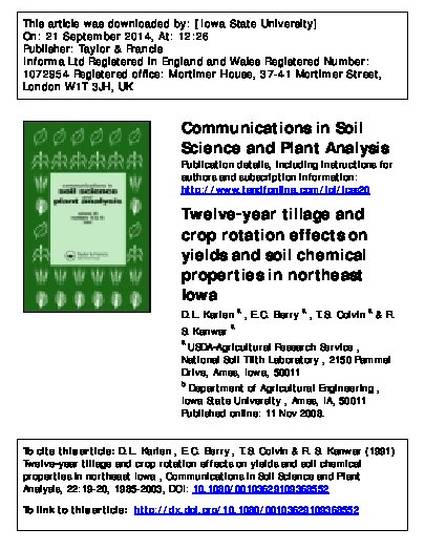
Long‐term tillage and crop management studies may be useful for determining crop production practices that are conducive to securing a sustainable agriculture. Objectives of this field study were to evaluate the combined effects of crop rotation and tillage practices on yield and changes in soil chemical properties after 12 years of research on the Clyde‐Kenyon‐Floyd soil association in northeastern Iowa. Continuous corn (Zea mays L.) and a corn‐soybean [Glycine max L. (Herr.)] rotation were grown using moldboard plowing, chisel plowing, ridge‐tillage, or no‐tillage methods. Tillage and crop rotation effects on soil pH, Bray P1, 1M NH4OAc exchangeable K, Ca, and Mg, total C, and total N in the top 200 mm were evaluated. Profile NO3‐N concentrations were also measured in spring and autumn of 1988. Crop yields and N use efficiencies were used to assess sustainability. Bray P1 levels increased, but exchangeable K decreased for all cropping and tillage methods. Nutrient stratification was evident for no‐tillage and ridge‐tillage methods, while the moldboard plowing treatment had the most uniform soil test levels within the 200 mm management zone. Chisel plowing incorporated fertilizer to a depth of 100 mm. Soil pH was lower with continuous corn than with crop rotation because of greater and more frequent N applications. Profile NO3‐N concentrations were significantly different for sampling depth and among tillage methods in spring 1988. In autumn the concentrations were significantly different for sampling depth and for a rotation by tillage interaction. Estimated N use efficiencies were 40 and 50 kg grain per kg N for continuous corn, and 48 and 69 kg grain per kg N for rotated corn in 1988 and 1989, respectively. The results suggest that P fertilizer rates can be reduced, but K rates should probably be increased to maintain soil‐test levels for this soil association. Crop rotation and reduced tillage methods such as ridge‐tillage or chisel plowing appear to meet the criteria for sustainable agriculture on these soils.
Available at: http://works.bepress.com/douglas_karlen/38/

This article is from Communications in Soil Science and Plant Analysis 22 (1991): 1985–2003, doi:10.1080/00103629109368552.